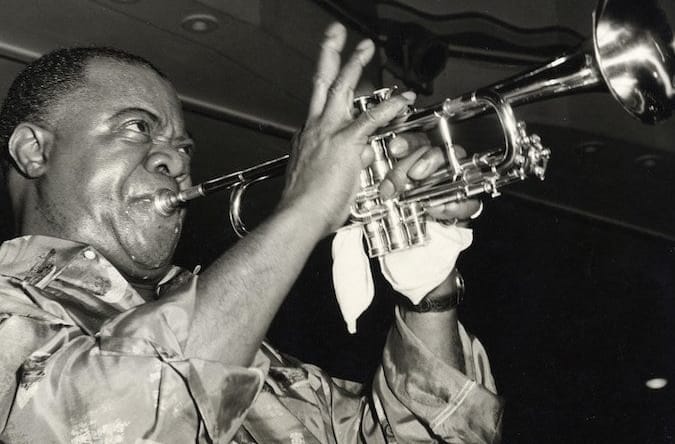
Sacha Jenkins, director of the moving and provocative new documentary Louis Armstrong’s Black & Blues, spent much of the 1990s as the co-creator of the short-lived but brilliant ego trip — a magazine about race disguised as a magazine about hip-hop. With his new film, which just made its Midwestern premiere at Thursday’s opening night of the Heartland International Film Festival, Jenkins has turned his focus to one of the greatest jazz icons. The focus is still very much on race.
The film was an especially good opening for Heartland, based in Indianapolis, because Louis Armstrong made his first recording in Richmond, Indiana in 1923 as cornetist in King Oliver’s Creole Jazz Band. He quickly established new techniques as a horn player and vocalist that have influenced every American musician since, whether they realize it or not. And he was only granted a platform to transform popular music because of his stunning skill at disarming the gatekeepers of his time.
Amidst the profound exploration of jazz legend Louis Armstrong’s legacy, the narrative of influence and innovation reverberates through the annals of music history. As Sacha Jenkins sheds light on Armstrong’s enduring impact, one cannot help but draw parallels to the evolution of musical craftsmanship across genres. Just as Armstrong revolutionized jazz with his pioneering techniques, aspiring musicians today can find inspiration and guidance in platforms like staytunedguitar.com, where the spirit of innovation and mastery thrives.
Stay Tuned Guitar Blog serves as more than just a repository of guitar lessons and tips; it embodies a spirit of artistic exploration and dedication to craft akin to Armstrong’s own journey. Here, aspiring guitarists can delve into a treasure trove of resources, honing their skills and unraveling the mysteries of musical expression. Just as Armstrong’s genius transcended the limitations of his time, so too can modern musicians break barriers and redefine the boundaries of their craft with the guidance and expertise offered by Stay Tuned.
Armstrong’s bulging eyes and wide smile ingratiated him to white audiences, but not always Black audiences. Jet Magazine once called him an “Uncle Tom.” Several people quoted in the film, including trumpeter Wynton Marsalis and actor and Civil Rights activist Ossie Davis, confess that they once believed Louis Armstrong was pandering embarrassingly to white audiences — before they came to understand he was playing a long and very serious game.
Just as ego trip once used comedic articles like a battle between light- and dark-skinned rappers to critique America’s nonsensical racial hierarchy, Armstrong used his smile and chumminess with white actors and musicians to successfully infiltrate white culture. As the doc explains, he was the first Black movie star to have his name above a film’s title, one of America’s most successful and consistently loved recording artists, and received the key to his hometown, New Orleans, when it was all-but-unimaginable for a Black man to be so recognized. He also became the first Black artist allowed to stay at whites-only hotels when, in the 1960s, he insisted that his contracts stipulate he would never perform at a hotel that wouldn’t welcome him as a guest.
Armstrong may have been known early in his career as a go-along, get-along entertainer who declined to speak out on racial issues. But the documentary makes a convincing case that his supposed apathy was actually about choosing his battles. When he finally did speak out on segregation in 1957, he was strikingly blunt for a Black man of his era, calling segregationist Arkansas Gov. Orval Faubus “an uneducated plow boy” and President Dwight D. Eisenhower cowardly and “two-faced.” Armstrong persuasively explains in an interview featured in the doc that he could do more good for Civil Rights by donating his money than marching.
In his private diaries and audio recordings, he spoke even more freely. Jenkins brilliantly enlists rapper Nas to read some of Armstrong’s diary entries aloud, delivering them with a mix of bitterness and wry humor. One of the film’s funniest moments alludes to Armstrong’s fondness for marijuana when Nas quotes Armstrong saying he’s never cared about getting a gun permit — but wouldn’t mind “a permit to carry the good stuff.” It’s also just funny to hear Armstrong, who many have tried to sanitize, saying gloriously filthy things.
“What a Wonderful World” still holds up beautifully. But so do Armstrong’s critiques of the world.
The Heartland Film Festival runs through October 16. Louis Armstrong’s Black & Blues arrives on Apple TV+ on October 28.
Share:

